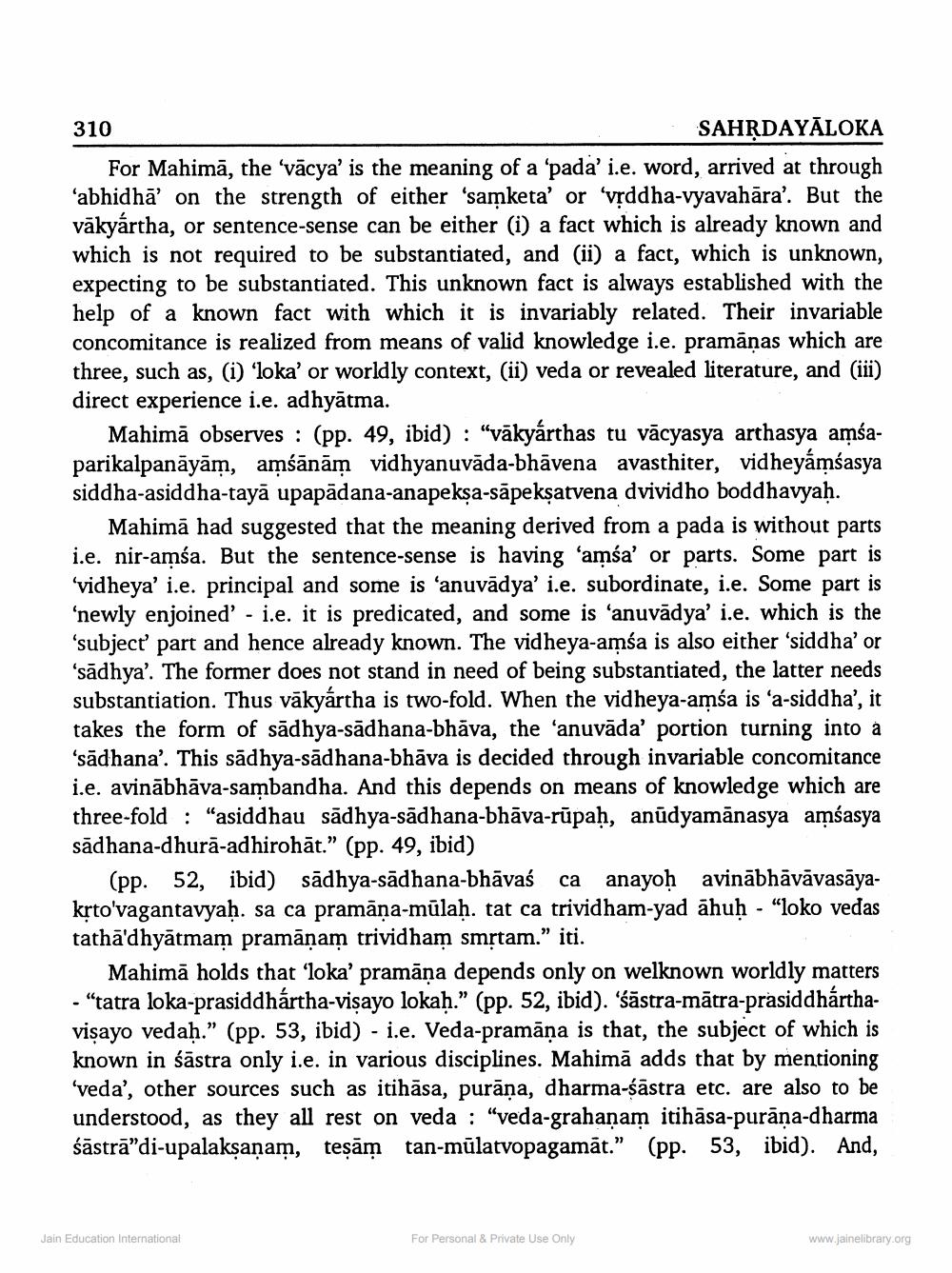________________
310
SAHRDAYĀLOKA For Mahimā, the 'vācya' is the meaning of a 'pada' i.e. word, arrived at through
na' on the strength of either 'samketa' or 'vrddha-vyavahāra'. But the vākyartha, or sentence-sense can be either (i) a fact which is already known and which is not required to be substantiated, and (ii) a fact, which is unknown, expecting to be substantiated. This unknown fact is always established with the help of a known fact with which it is invariably related. The concomitance is realized from means of valid knowledge i.e. pramānas which are three, such as, (i) 'loka' or worldly context, (ii) veda or revealed literature, and (iii) direct experience i.e. adhyātma.
Mahimă observes : (pp. 49, ibid) : "vākyarthas tu vācyasya arthasya ambaparikalpanāyām, amśānām vidhyanuvāda-bhävena avasthiter, vidheyámśasya siddha-asiddha-tayā upapādana-anapekșa-sāpekșatvena dvividho boddhavyaḥ.
Mahimā had suggested that the meaning derived from a pada is without parts i.e. nir-amsa. But the sentence-sense is having 'amśa' or parts. Some par 'vidheya' i.e. principal and some is 'anuvādya' i.e. subordinate, i.e. Some part is 'newly enjoined' - i.e. it is predicated, and some is 'anuvādya' i.e. which is the 'subject part and hence already known. The vidheya-amsa is also either 'siddha' or 'sādhya'. The former does not stand in need of being substantiated, the latter needs substantiation. Thus vākyártha is two-fold. When the vidheya-amsa is ‘a-siddha', it takes the form of sādhya-sādhana-bhāva, the 'anuvāda' portion turning into a 'sādhana'. This sādhya-sādhana-bhāva is decided through invariable concomitance i.e. avinābhāva-sambandha. And this depends on means of knowledge which are three-fold : "asiddhau sādhya-sādhana-bhāva-rūpaḥ, anūdyamānasya amśasya sādhana-dhurā-adhirohāt.” (pp. 49, ibid)
(pp. 52, ibid) sādhya-sādhana-bhāvaś ca anayoh avinābhāvāvasāyakrto'vagantavyah. sa ca pramāna-mülah. tat ca trividham-yad āhuh - "loko vedas tathā'dhyātmam pramānam trividham smstam." iti.
Mahimā holds that 'loka' pramāna depends only on welknown worldly matters - "tatra loka-prasiddhártha-visayo lokah.” (pp. 52, ibid). 'śāstra-mātra-prasiddharthavisayo vedah.” (pp. 53, ibid) - i.e. Veda-pramāņa is that, the subject of which is known in śāstra only i.e. in various disciplines. Mahimā adds that by mentioning 'veda', other sources such as itihāsa, purāna, dharma-śāstra etc. are also to be understood, as they all rest on veda : "veda-grahanam itihāsa-purāņa-dharma śāstrā”di-upalakṣaṇam, teşām tan-mūlatvopagamāt.” (pp. 53, ibid). And,
Jain Education International
For Personal & Private Use Only
www.jainelibrary.org




